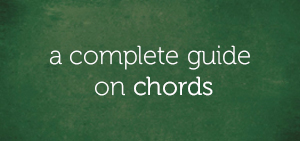If you’re interested in learning how experienced players memorize chords using color patterns, this lesson is for you.
One challenge that is common to all beginners and intermediate players is the memorization of chords in all twelve keys and this is because the list of chords — from triads to seventh chords, to extended chords – is inexhaustible.
In this lesson, you’ll discover how the process of memorizing chords can be simplified using color patterns. But before we go into that, let’s take a look at the concept of color patterns.
The Concept Of Color Patterns
A chord is a product of the relationship between three or more related notes which may be played or heard together. There are various chord classes ranging from triads (three note chords) like the C major triad:
…to sixth and seventh chords (four note chords) like the F minor seventh chord:
…to extended chords (consisting of more than notes) like the D dominant ninth chord:
The notes of these chords can be represented using the color of the notes – white or black. For example, the C major triad (which consists of three white notes):
…can be represented thus:
White-White-White
…or using the first letter of the word white:
W-W-W
The F minor seventh chord:
…can be represented thus:
White-Black-White-Black
…or using the first letter of the word white and the first letter of the word black:
W-B-W-B
The D dominant ninth chord:
…can be represented thus:
White-Black-White-White-White
…or using the first letter of the word white and the first letter of the word black:
W-B-W-W-W
“Of What Importance Is The Concept Of Color Patterns?”
The concept of color patterns is of the greatest importance when it comes to the memorization of a chord. When the notes of a D major triad cannot be recalled, anyone can rely on its color pattern:
White-Black-White
or:
W-B-W
…and recall the D major triad:
D is white
F# is black
A is white
This favors mostly beginners who are yet to memorize the D major triad and are always mistaken into playing the D minor triad:
…instead of the D major triad:
It becomes easier for anyone to memorize the D major triad:
…and difficult for the D minor triad (W-W-W):
…to be mistaken for the D major triad (W-B-W):
How To Memorize Chords Using Color Patterns
While learning how to play chords on the piano, most beginners and intermediate players are subjected to the rigorous process of learning a chord in twelve keys and that can be tasking most of the time.
However, using the concept of color patterns, a group of chords can be memorized when they share exactly or nearly the same color pattern.
For example, the color pattern W-W-W can be associated with the following triads:
C major triad
F major triad
G major triad
“Check It Out…”
C major triad:
…all white notes.
F major triad:
…all white notes.
G major triad:
…all white notes.
So, using one color pattern:
White-White-White
…three out of all the twelve major triads (25%) can be memorized.
Final Words
Believe it or not, even the most advanced players on the planet use color patterns in the memorization or recognition of chords.
If it’s helped everyone of them, then I’m doubly sure it would help you as well.
See you in the next lesson.
Chuku Onyemachi
Latest posts by Chuku Onyemachi (see all)
- The Formation Of Diminished Seventh Chords Used To Be Challenging Until I Did This
- How To Form Seventh Chords In Two Shakes Of A Dog’s Tail Using Third Intervals And The Circle Of Fifths Chart
- I Played The 13sus4 Chord And This Happened…
- How To Build Seventh Chords Like An Architect Using “Foundation And Structure” Concept
- This 4-Week Plan Will Help You Master All The Major Scales







Comments on this entry are closed.